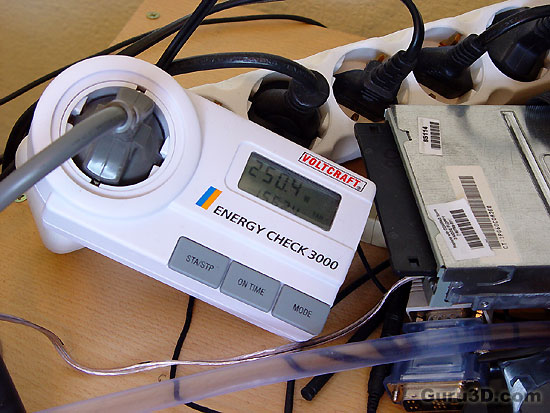Page 4
Power Supply - Watt Did You Say?![]()
The dreaded word in the industry: power consumption. The GeForce 7600GT & 7900GT require a stable 12-volt power source for best performance, reliability and most of all that gaming experience of yours. We tested a lot of PSU's lately, be sure to read through a couple of reviews.
For a GeForce 7900 GT or GTX graphics card, NVIDIA recommends a 350-400 watt power supply with 22-26 ampere on the 12 volts rails. NVIDIA is recommending nothing too over-the-top in terms of wattage for the power supply unit, yet be aware as that's a lot of Ampage on the 12 volts rails. What we always do with new graphics' cards, we measure the wattage peak with the help of a wattage meter. Slight side note, you are looking at the overall usage of the entire PC.
The meter is placed between the power connector and the PSU. You basically look at how much power is being pulled from your wall socket, so you need to look at the results as being an indication and not an exact science.
Let's have a look at the two products:
| Card |
W
e simply look at the peak Wattage during a 3DMark05 session to verify power consumption. You are not looking at the power consumption of the graphics card, but of the entire PC.
An example of how we measure.
So indeed, you need 350w at the least as you want some spare wattage and 420 Watts or better is definitely recommended. When you buy a new PSU you need to look at the packaging and check the AMPS on the 12 volts rail. It should be 22 AMPS minimal (for the total of +12 volts rails).
If in a later stage or immediately you decide to go for SLI then we need to redo the math. For two 7600 GT's the 420 Watts PSU should still be sufficient. But for the 7900 GT SLI I do recommend a 520 Watt SLI-Ready PSU, preferably with dual 12 volts rails.
There are some good SLI certified PSU's out there, again have a look at our PSU reviews.What would happen if your PSU can't cope with the load?:
- bad 3D performance
- crashing games
- spontaneous resetting PC
- freezes during gameplay
- PSU overload can cause it to break down
So many things can happen.
Dangerous Liaisons - temperatures of the graphics card![]()
Both the 7600 GT and 7900 GT products from BFG have the reference coolers as specified by NVIDIA. The coolers are working quite well. Let's have a look at the temperatures these cards produce. We measured at a room temperature of 23 Degrees C.
| Card | Temperature in idle (Celsius) |
A maximum of 72 Degrees C peak temperature was monitored from the 7900 GT, and a max of 66 Degrees C from the 7600 GT. Both the 7600 GT & 7900 GT show very acceptable temperature levels. Yet since the heat is being dumped inside your PC you always need to be sure that inside is well ventilated.
Noise Levels coming from the graphics cardWhen graphics cards produce a lot of heat usually that heat needs to be transported away from the hot core as fast as possible. Often you'll see massive active fan solutions that can indeed get rid of the heat, yet all the fans these days make the PC a noisy son of a gun.
This is a very subjective test, but we bought a certified dBA meter and we'll start measuring how many dBA originate from the PC. Why is this subjective you ask? Well, there is always noise in the background, from the streets, from the HD, PSU fan etc etc, so this is by a mile or two not a precise measurement. You could only achieve objective measurement in a sound test chamber.
The human hearing system has different sensitivities at different frequencies. This means that the perception of noise is not at all equal at every frequency. Noise with significant measured levels (in dB) at high or low frequencies will not be as annoying as it would be when its energy is concentrated in the middle frequencies. In other words, the measured noise levels in dB will not reflect the actual human perception of the loudness of the noise. That's why we measure the dBa level. A specific circuit is added to the sound level meter to correct its reading in regard to this concept. This reading is the noise level in dBA. The letter A is added to indicate the correction that was made in the measurement.
|
TYPICAL SOUND LEVELS | ||||
Jet takeoff (200 feet)
120 dBA
Construction Site
110 dBA
Intolerable
Shout (5 feet)
100 dBA
Heavy truck (50 feet)
90 dBA
Very noisy
Urban street
80 dBA
Automobile interior
70 dBA
Noisy
Normal conversation (3 feet)
60 dBA
Office, classroom
50 dBA
Moderate
Living room
40 dBA
Bedroom at night
30 dBA
Quiet
Broadcast studio
20 dBA
Rustling leaves
10 dBA
Barely audible
We startup a benchmark, we take the dBA meter, move away 75 CM and then aim the device at the active fan on the graphics card.
| Card |
We measure roughly 50 dBa on both products, which is to be considered a moderate noise level coming from the PC. Again, this is a very subjective test. I do think that the reference coolers are a tad too noisy.
